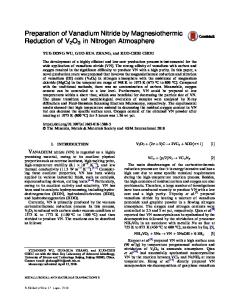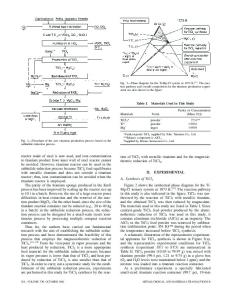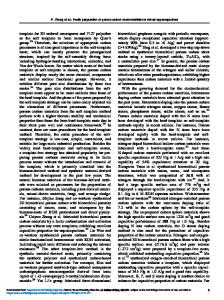Preparation of graphene-like carbon attached porous silicon anode by magnesiothermic and nickel-catalyzed reduction reac
- PDF / 1,621,958 Bytes
- 10 Pages / 595.276 x 790.866 pts Page_size
- 83 Downloads / 387 Views
ORIGINAL PAPER
Preparation of graphene-like carbon attached porous silicon anode by magnesiothermic and nickel-catalyzed reduction reactions Jinqiu Zhang 1 & Yuefei Chen 1 & Xueqin Chen 2 & Tianyu Feng 2 & Peixia Yang 1 & Maozhong An 1 Received: 4 July 2020 / Revised: 16 August 2020 / Accepted: 17 August 2020 # Springer-Verlag GmbH Germany, part of Springer Nature 2020
Abstract For improving performance of silicon anode in lithium ion batteries, a two-step preparation method was applied for synthesis of silicon carbon powder. The first step was to prepare Si/Ni composite powder by magnesiothermic reduction reaction in which Tetraethoxysilane (TEOS) was silicon source and NiCl2∙6H2O was nickel source. The second step was to prepare silicon carbon in which triethylene glycol was carbon source and reduced by nickel catalyzed reactions on the surface of Si/Ni composite particles. Strawberry-like porous silicon attached with graphene-like carbon was found in the sample of Si-C powder treated by 1 M FeCl3 and 5 wt.% HF. Charge/discharge performance of anode materials were measured in button cells. The highest discharge specific capacity of Si-C powder can reach to 1275 mAh g−1, but the cycle performance was not as good as Si/Ni composite powder. At the 50th cycle, the discharge specific capacity of Si/Ni composite powders and Si-C powders were 415 mAh g−1 and 395 mAh g−1, respectively. Keywords Silicon carbon anode . Lithium ion battery . Magnesiothermic reduction reaction . Nickel catalyzed reduction reaction . Silicon nickel composite material
Introduction Lithium ion batteries are widely used in portable electronic products. Due to the increasing dependence of people on intelligent electronic products such as phones and tablets, the demand for high specific energy batteries is also growing. Researchers are looking for new anode materials to replace the traditional graphite which theoretical specific capacity is 372 mAh g−1. Silicon material is a promising anode material for lithiumion battery. The theoretical specific capacity of silicon is over 4200 mAh g−1, 10 times that of carbon anode [1]. Silicon has the similar lithium insertion potential as carbon materials for lithiumion batteries. However, during the charging * Jinqiu Zhang [email protected] * Tianyu Feng [email protected] 1
MIIT Key Laboratory of Critical Materials Technology for New Energy Conversion and Storage, School of Chemistry and Chemical Engineering, Harbin Institute of Technology, Harbin 150001, People’s Republic of China
2
School of Astronautics, Harbin Institute of Technology, Harbin 150001, People’s Republic of China
and discharging process, the silicon anode material has an enormous volume extension, resulting in the cracking and pulverization of silicon particles, followed by sudden increase of internal resistance of lithiumion battery and rapid fading of specific capacity in 10 cycles [2, 3]. Unstable solid electrolyte interface (SEI) film of Si electrode during lithiation/delithiation, as well as the poor electron conductivity ha
Data Loading...






